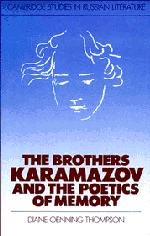Book contents
- Frontmatter
- Contents
- Preface
- Note on the text
- 1 Memory and poetics
- 2 The fictional narrator
- 3 Memory and the system of ascending plots
- 4 The memories of the characters: forms of affirmative memory
- 5 The memories of the characters: forms of negative memory
- 6 Forgetting
- 7 Foretelling
- 8 The Christocentric poetic memory system
- 9 Afterword
- Notes
- Bibliography
- Index
- Titles in the series
3 - Memory and the system of ascending plots
Published online by Cambridge University Press: 05 November 2011
- Frontmatter
- Contents
- Preface
- Note on the text
- 1 Memory and poetics
- 2 The fictional narrator
- 3 Memory and the system of ascending plots
- 4 The memories of the characters: forms of affirmative memory
- 5 The memories of the characters: forms of negative memory
- 6 Forgetting
- 7 Foretelling
- 8 The Christocentric poetic memory system
- 9 Afterword
- Notes
- Bibliography
- Index
- Titles in the series
Summary
Reason discerns, memory keeps the conscience.
Various stories have long been circulating in the Western collective memory, some fictional (myths, folklore, imaginative literature), others having a basis in history (epics, biblical narratives, saints' lives). If an author believes that one of these stories has a pre-eminent claim to truth, and if it has long been the object of his searching meditations, he will usually attempt to incorporate this truth into his own work. All the more so if he is convinced that the old truths are relevant to his confused epoch and that his contemporaries need to be reminded of them. On the other hand, he knows he has to tell an absorbing new story that makes sense to his contemporaries, but which is sufficiently serious and problematic to carry the old truths, a story that is emblematic of his troubled times. Among the invariants which withstand the erosion over time of historically conditioned elements is the plot, that major structural pattern for unifying events, ordering meanings and mediating an ideal. One way of matching his modern story with an old one is to embed the old plot in his narrative. This is essentially the artistic task Dostoevsky set himself when he wrote his last novel.
Confronted with the scope and complexity of The Brothers Karamazov, most interpreters divide it into several ‘plans’ or ‘levels’, while some, finding the term ‘novel’ inadequate, annex another generic term to describe its dominant character.
- Type
- Chapter
- Information
- The Brothers Karamazov and the Poetics of Memory , pp. 52 - 73Publisher: Cambridge University PressPrint publication year: 1991



